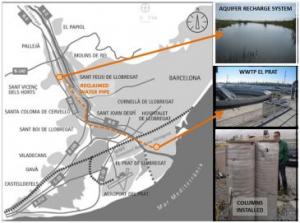This report corresponds to the second part of the D12.3. The document summarises the practical application of the guidelines presented in the D12.3(a), and corresponds to the experiment carried out in Barcelona, in the waste water treatment plant of El Prat del Llobregat to test the effectiveness of a natural and an enhanced simulated SAT system. 11 selected pharmaceuticals (target compounds of DEMEAU project) present in secondary effluent have been quantified in the inlet and outlet of the soil-column experiments to evaluate the fate of these compounds after a natural filtration process. Two parallel columns simulated the infiltration pond of Sant Vicenç dels Horts before the implementation of the reactive layer, while two additional doubled columns simulated the implementation of a compost-made reactive layer before the aquifer infiltration. Results showed great differences in the elimination of pharmaceuticals along the experiment in natural and enhanced conditions. 3 different groups have been created to summarise the behaviour of the 11 organic compounds. While 7 of them didn’t have a representative increase of elimination under enhanced conditions, 4 noticed better removal percentage in the enhanced system. Duplicated systems proved robustness in the acquisition of results, as both columns gave same results in terms of concentration and elimination of most of the parameters analysed. Comparison with field experiments have been already done. Elimination percentages reported in full-scale MAR systems are higher than those observed in the soil-column experiment. This is an important fact to take into account and reveals that soil-column experiments are quite limited to simulate MAR systems and their complexity.

